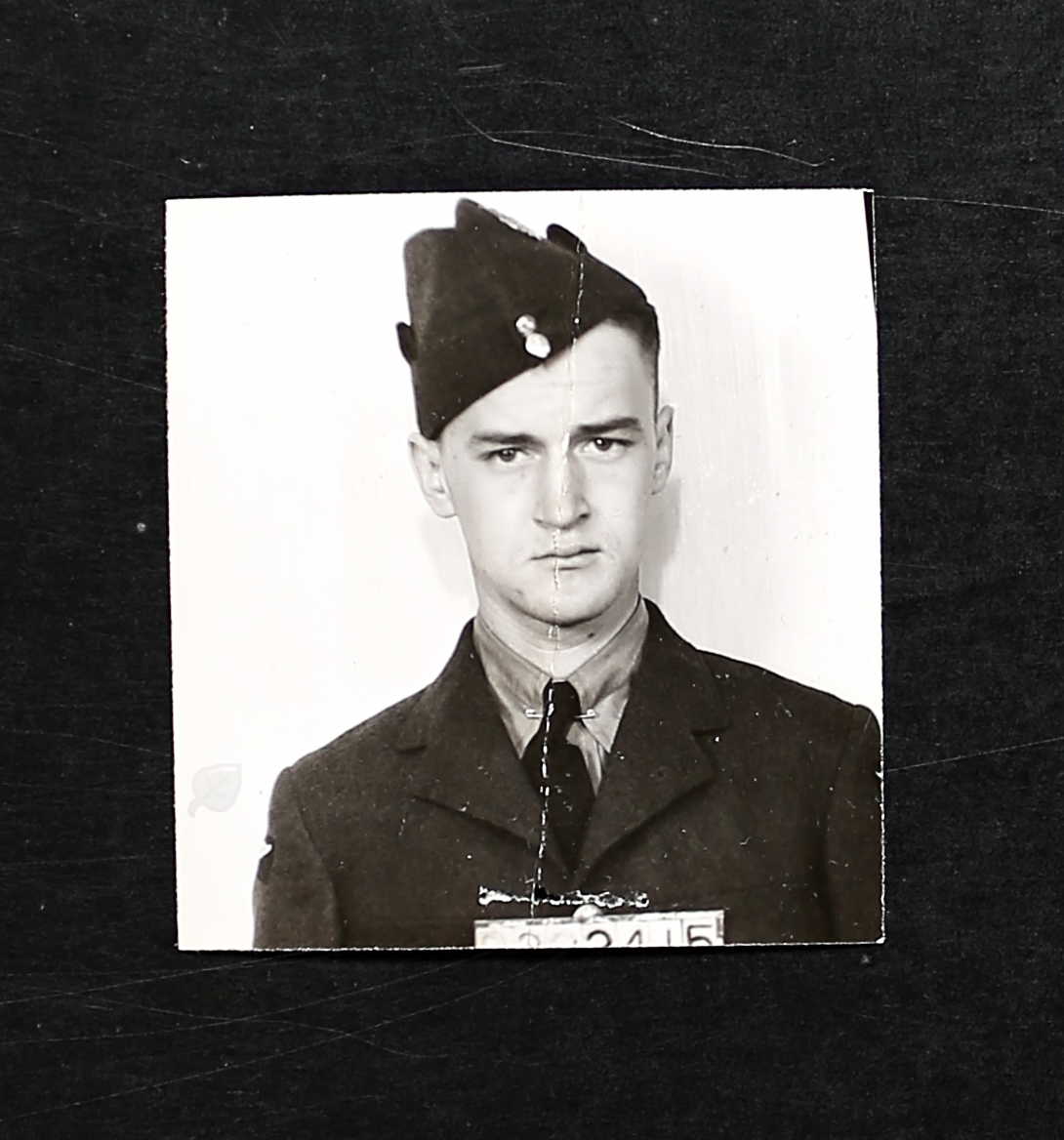
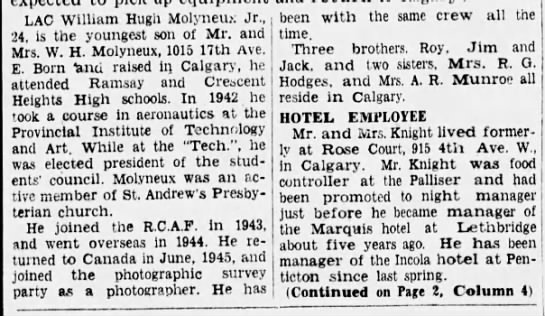
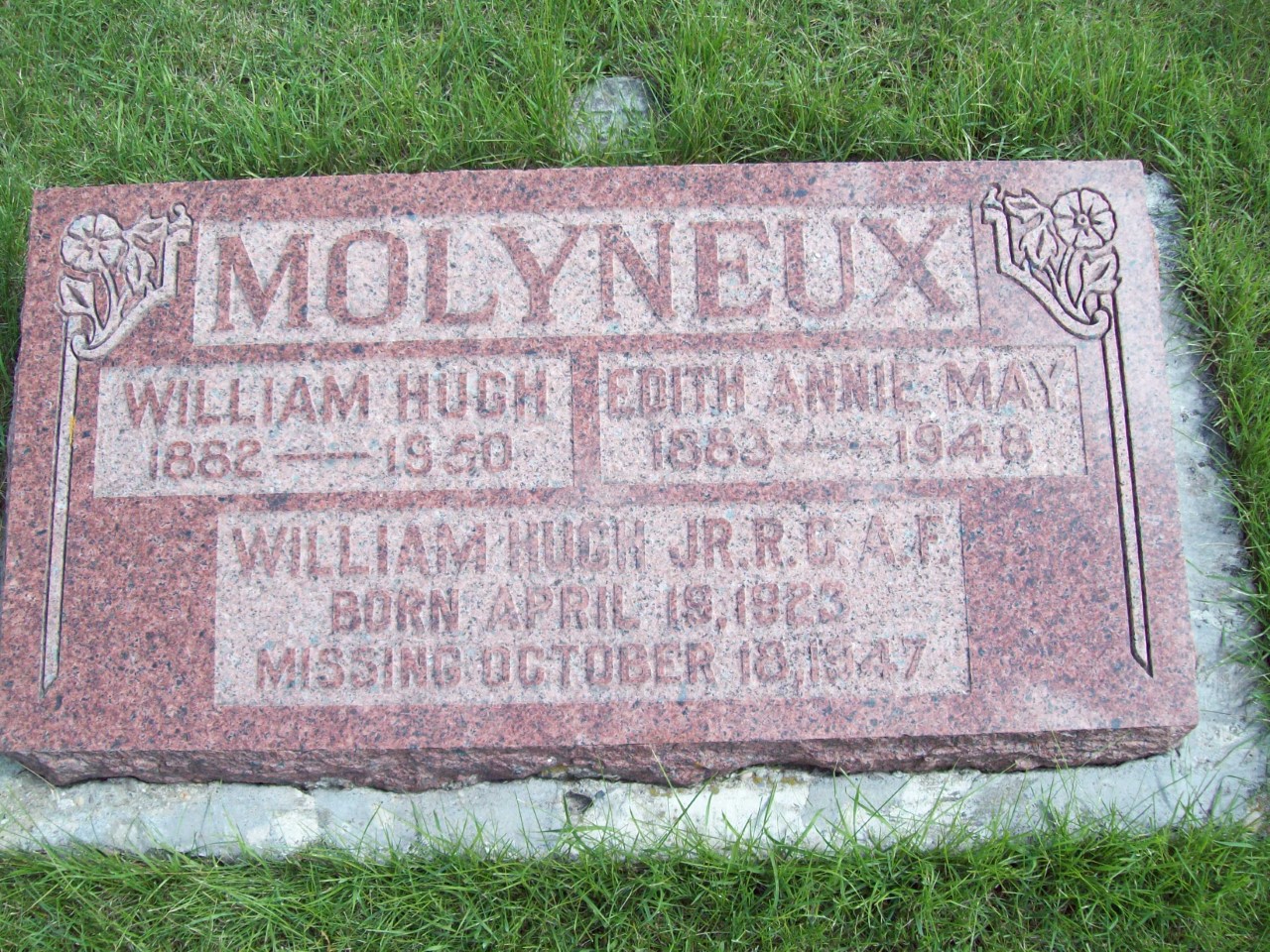
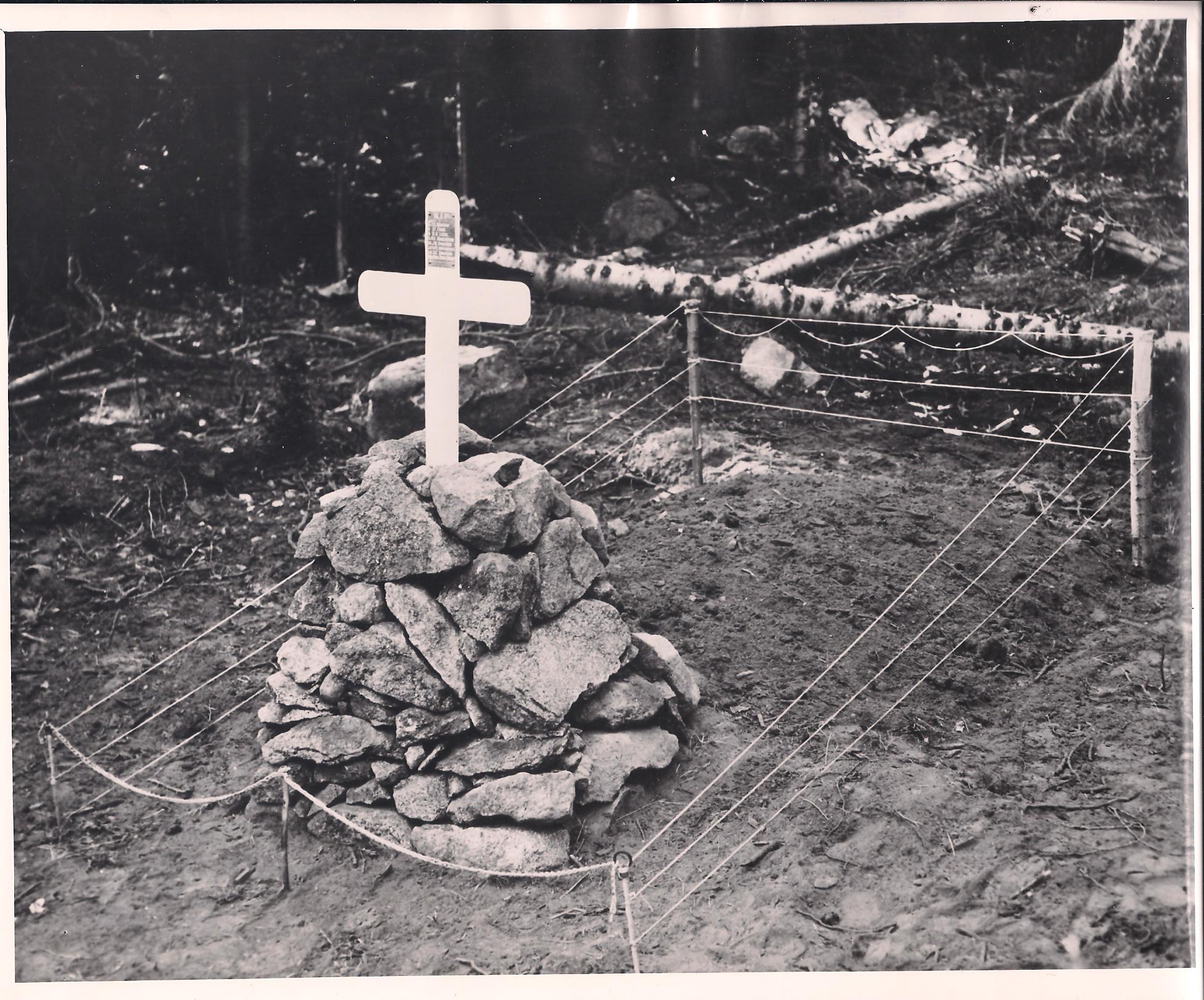
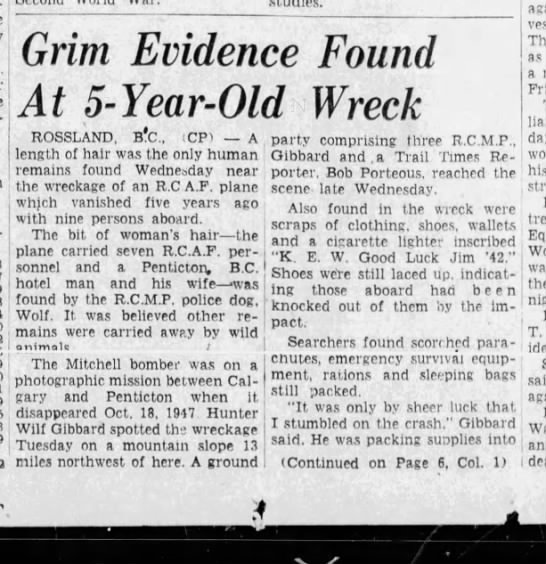
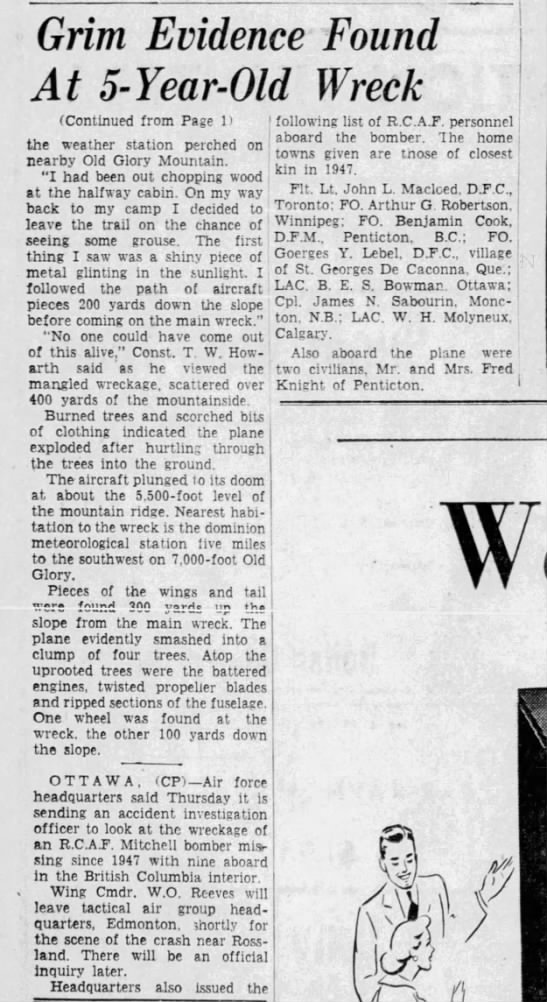
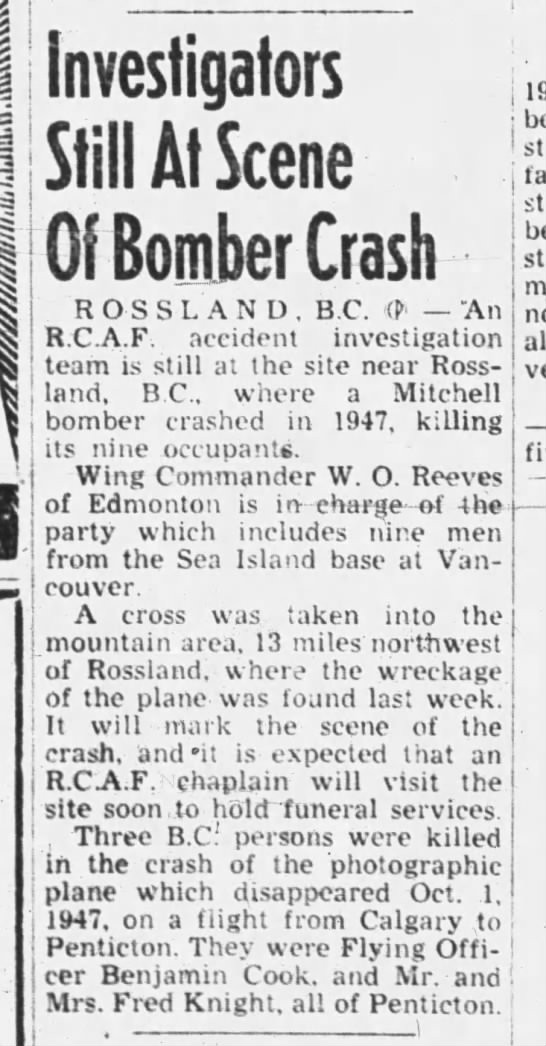
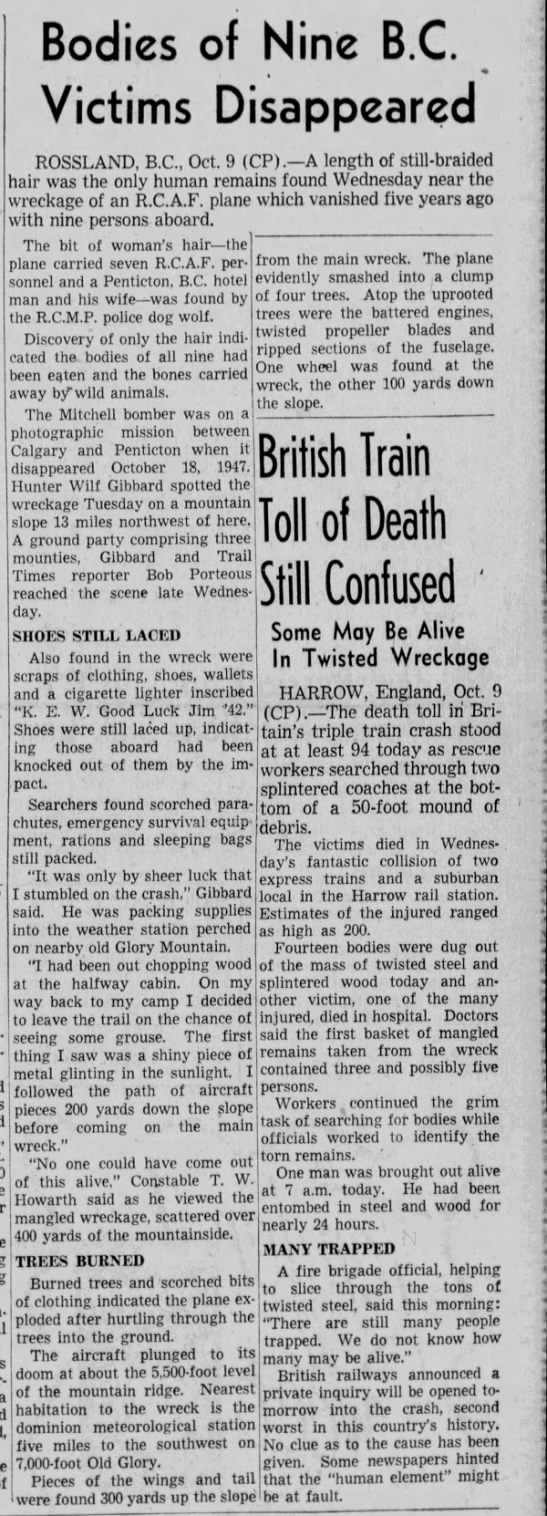


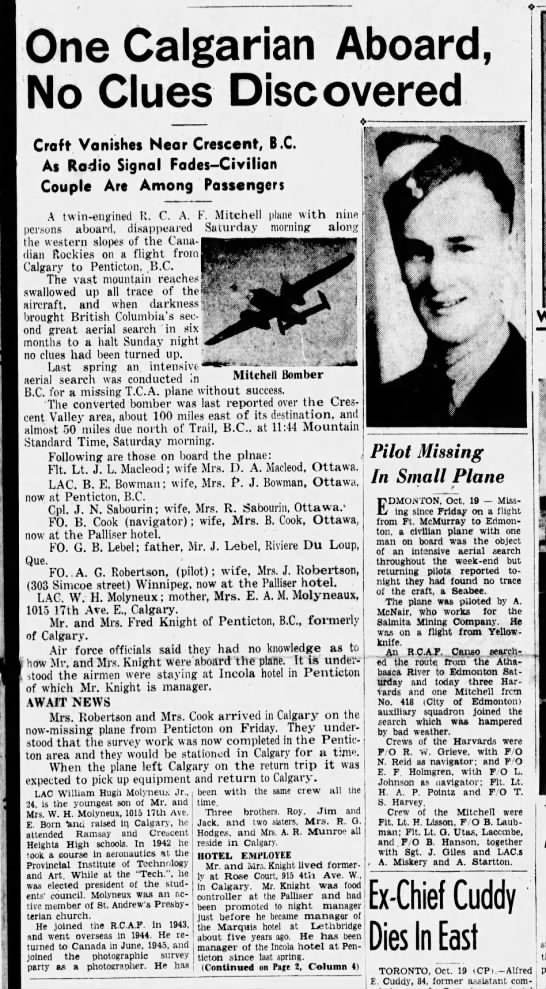
April 19, 1923 - October 18, 1947











William “Bill” Hugh Molyneux was the youngest child of William Hugh Molyneux, Sr.(1882-1950), trainman for the CPR, and Edith Annie May (nee Fleury) Molyneux (1883-1948) of Calgary, Alberta. He had two sisters, Mrs. Evelyn Hodge (1917-2012) and Mrs. Edith Clarabel Munro (1921-1964), and three brothers: Roy Blair (1912-1996), James Henry, and John Keith. All resided in Calgary. The family was Presbyterian.
Bill had a Grade XI education plus one year of aeronautics. He was unemployed when he enlisted with the RCAF in May 1943. He had worked for seven months for the CPR, car service. After the war, he hoped to return to aeronautics school and pursue employment in aeroplane manufacturing.
He had delayed enlisting with the RCAF because his family wanted him to continue his schooling. “Neat appearance, pleasant lad, seems wide awake, but realizes he has wasted a bit of time up to date, however, promises to turn over a new leaf and really get down to work now.” Another note, “Watch this lad. See that he works.”
He had $60 in a bank account with the Imperial Bank of Canada, plus two life insurance policies, his parents the beneficiary.
On his medical form in early 1943, he had one year Crescent Heights Cadets and one month with the Calgary Regiment. He liked basketball and bowling, smoked ten cigarettes per day and indicated he did not drink alcohol. Occasionally, he had burning epigastric distress after eating certain acidic foods, relieved by soda, with no suggestion of an ulcer. “Wiry, standard mentality.” He had a small scar lower anterior right thigh and a faint linear scar, medical side of left leg. William stood 5’9” tall and weighed 133 pounds, had blue eyes and brown hair. “Physically fit, good material. He is keen to get into aircrew and is taking a course in aeronautics. He appears to be a good type of candidate and I am sure would make good.” F/L A. S. Underhill.
On an Aircrew Interview Report Form, William indicated that his family was quite favourably disposed towards his enlistment, his family was well provided for, he was a fairly progressive type, he seemed likely to develop and mature, and was eager to be a member of aircrew. He had limited knowledge about the Air Force, felt always at ease, was smart and alert and stated what he meant clearly. Out of a maximum score of 100, he scored a 66.
Bill was at Edmonton’s Manning Depot from June 7 to June 28, 1943, then went to No. 2 Wireless until October 30, 1943.
At No. 7 ITS, Saskatoon, Saskatchewan, November 15, 1943 to January 28, 1944: “This airman will have to be checked frequently to insure that he is working. Hospitalized.” March to May 1944: “Bright, pleasant and likeable, but lacking in application on course, consequently obtaining a low standing. Good motivation but appears to require further service experience before receiving aircrew training. Has been hospitalized from time to time which may have contributed to his lack of application.” On February 2, 1944, while playing floor hockey at No. 7 ITS, “While I was running with the puck when another fellow ran into me. I then experienced a roaring sound in my right ear. I did not think much of it so did not report to the MO till this morning.” His injury: Traumatic rupture of right ear drum.
He ceased his training at ITS. He remustered to photographer.
He was at No. 13 SFTS from June 16 to September as U/T photographer. Then assigned to No. 7 Photo Wing, Rockcliffe September 3 to November 10, 1943, taking a photo course. From September 4 to November 24, 1944: “Theory: written 63%, practical 82%. Final average: 72.5%. Deportment good. Technical ability satisfactory.”
On September 9, 1944, Bill was involved in the theft of whiskey along with two other LACs while at No. 2 B&G School, Mossbank, Saskatchewan. “LACs Molyneux, Johnson, and Howard were charged with breaking into AC2 Duguet’s locker and stealing three bottles of liquor therefrom. They were paraded September 11, 1944, pleaded guilty as charged and were remanded under open arrest for taking of a summary of evidence. The personnel who made statements in this case were all duly warned before making their statements. LAC Molyneux was charged with being in improper possession of the said liquor and awarded 72 hours detention on the 21st September 1944.”
He continued as a photographer at No. 2 FIS, Pearce, Alberta November 1944 to January 1945, then at Souris, Manitoba before being was sent overseas for five months arriving in the UK March 26 until August 27, 1945.
Bill was released from the RCAF effective October 6, 1945. After the war, on his personnel counselling report: “Career chosen: railroad brakeman, CPR. Plans to realize career: seek job with CPR, possibly take re-establishment.” He hoped to take an advanced course in photography in order to take a position with the Public relations Branch of the CPR. “His abilites are above this type of work. His father and other relatives are employed on the CPR. Molyneux stands a very good chance of getting a position with the Public Relations Department of the CPR. A course in advanced photography would be of great value to him for this job. He is clever, efficient and well able to meet the public. Would recommend this course for easons of reinstatement in a better position. The car-cleaning job is a temporary measure.”
Mitchell 894 left Calgary, Alberta at 1032 hours, October 18, 1947 on a flight to Penticton, BC, estimated time en route, one hour forty-five minutes. Approximately one hour later, 1132 hours, the aircraft requested Crescent Valley Radio range for Penticton weather, by wireless, but did not give their position. This was given, but not acknowledged by the aircraft. Continuing in a letter by W/C W. R. Gunn, the families were told that the route of the aircraft was over a practically inaccessible area. Air and ground searches were conducted for many weeks, but due to severe winter weather, they were terminated. Several searches continued during better weather without success.
CREW: • Bliss Eugene Strader Bowman, R195797, LAC -- Aero Engine Mechanic o SON OF JAMES AND OLIVE BOWMAN; HUSBAND OF JOYCE BOWMAN, OF INKERMAN, ONTARIO. • Georges Yvon Lebel 26356, F/O, DFC -- Wireless Operator o SON OF JEAN BAPTISTE LEBEL AND CORDELIA LEBEL, OF RIVIERE-DU-LOUP, PROVINCE OF QUEBEC • Benjamin Cook, 19826, F/O. He earned the DFM. -- Navigator o SON OF WILLIAM JEFFERSON COOK AND EDITH COOK; HUSBAND OF GLADYS MATHER COOK, OF PENTICTON, BRITISH COLUMBIA • William Hugh Molyneux 24798, LAC -- Camera Operator o SON OF WILLIAM HUGH AND EDITH MOLYNEUX • John Leslie MacLeod, 20052, F/L, DFC -- Pilot o SON OF DONALD ALEXANDER AND BLANCHE LOUISA MACLEOD, OF CORNWALL, ONTARIO; HUSBAND OF DOROTHY ALICE MACLEOD • Arthur Gold Robertson, J28663, F/O - Pilot o SON OF JAMES PAUL AND JANET GEORGINA ROBERTSON OF STONEY MOUNTAIN, MANITOBA, AND HUSBAND OF MURIEL IRENE ROBERTSON. • James Noah Sabourin, 22103, Cpl - Airframe Mechanic o SON OF JOSEPH NOAH AND EDITH SABOURIN; HUSBAND OF RUTH C. M. SABOURIN, OF MONCTON, NEW BRUNSWICK
Two civilians: Frederick M. Knight and Beulah Jane (nee Braid) Knight, formerly of Calgary, were also aboard. Mr. Knight was the manager of the Incola Hotel, Penticton, BC, having been in the hotel business for 18 years, posted to Calgary and Lethbridge prior. They had three children: Cecile, 9, Joan, 5, and Billy, 6. The children were taken in by Mr. Knight’s brother, Mr. WG Braid of Winnipeg. “The Board of Inquiry…indicates that the crew stayed at the Incola Hotel in Penticton which was managed by Mr. Knight. Mr. and Mrs. Knight were quite friendly with the crew, entertained them, and showed them a good time. In view of this, it is presumed that, contrary to regulations, the crew took them along for the ride…Mr. and Mrs. Knight…were unauthorized passengers and there could be no legal liability on the part of the Crown to their estates. Since legal liability is denied, and because Mr. and Mrs. Knight were unauthorized passengers, a gratuitous allowance is not considered warranted.”
The Calgary Albertan reported on October 20, 1947 that Mrs. Robertson and Mrs Cook arrived on the missing aircraft from Penticton on the Friday. “They understood that the survey work was now completed in the Penticton area and they would be stationed in Calgary for a time. When the plane left Calgary on the return trip, it was expected to pick up equipment and return to Calgary.”
“Five aircraft from Edmonton and two from Vancouver scoured some 30,000 square miles of BC territory…paratroopers flown from Edmonton were standing by in Penticton, ready to jump to the help of the missing plane’s passengers and crew. In addition, 10 planes from the US combed the area of the international border for the missing aircraft, taking off from Seattle. Northwest Air Command revealed that the Mitchell plan was a photographic survey aircraft. It had been carrying out aerial mapping of the Penticton area and was based at the BC town. The craft flew to Calgary Friday and tried to return to its base on the same day. However, icing conditions at 16,000 feet forced it to return to Calgary for the night. It took off from the municipal airport at 1032 am Saturday. It was last heard from one hour and 20 minutes later when it signalled the radio range station at Crescent Valley, BC. The pilot asked for a report on the weather at his point of destination: Penticton. He said he had sufficient gas for a further four hours flying. When the plane left Calgary, it was expected to arrive at Penticton in about two hours but had fuels for a flight of six hours aboard. At the Calgary municipal airport, officials said, to the best of their knowledge, the RCAF transport was to have flown across country along a practically straight line between Calgary and its BC base.” [See articles above.]
A letter arrived dated December 17, 1947 from Dorothy A. West. “I was engaged to a Canadian serving in the RCAF and my last letter was returned marked ‘on place missing since October 28, 1947.’ I would very much appreciate any information you could give me concerning my fiancé and if the plane has been found.” Miss West lived in Notts, England.
She received a letter dated January 9, 1948 from W/C W.R. Gunn. “I regret to advise you that nothing is known of the aircraft of the crew since October 18, 1947. The aircraft took off from Calgary, Alberta en route to Penticton, British Columbia, October 18, 1947 and while nothing is known of the aircraft of the occupants, due to the lapse of time, it must regretfully be assumed that they all lost their lives.”
Mrs. Molyneux received a letter from W/C Gunn informing her that for official purposes, William was presumed to have died. She responded April 23, 1948, “Thank you for your kind letter. We have never had any other word of our son, only from the RCAF. I wonder if you could let us know if the search will be continued. My husband and I hope that it will. And that they will be found.”
Bill’s brother, John wrote a letter in April 1948, thanking the RCAF for their letter. “Although we have expected information of this nature for some time, we had hoped, and will continued to hope more for specific news will come in the near future. It is impossible to believe Bill could disappear without a trace of his whereabouts. Please accept my thanks for your act of human kindness in sending us this advanced notice of the official announcement, which I can assure you will tend to enlighten our hears with such news is received.”
In October 1952, the Windsor Star reported that a wreckage was found in the BC interior. The Vancouver Sun had a full report. The reporter from the Trail Times, Bob Porteous, went to the crash site by pack horse and on foot. “A junkyard of death high in the mountains.”
Wilf Gibbard spotted the wreck while out hunting near Rossland, BC. “It was only by sheer luck that I stumbled on the crash.I had been out chopping wood at the halfway cabin. On my way back to my camp, I decided to leave the trail on the chance of seeing some grouse. The first thing I saw was a shiny piece of metal glinting in the sunlight. I followed the path of aircraft pieces 200 yards down the slope before coming on the main wreck.”
“THE AIRCRAFT STRUCK AT 62OO FOOT LEVEL IN A HOURSEHOE ENCLOSURE ON THE EAST SLOPE OFF MOUNT GLORY. AIRCRAFT IMPACT DIRECTION IS WEST TO EAST DOWN SLOPE, BUT DISTANCE DOWN FROM THE TOP (3/4 MILE) AND STEEPNESS PRECLUDES POSSIBLITY OF AIRCRAFT APPROACH FROM WEST. DESCENT IS CONSIDRED TO HAVE BEEN IN OUT OF CONTROL, SPIN, OR SPIRAL CONDITION. ALL COMPONENTS FOUND NEAR BY. ALTHOUGH WATCHES VARY, THERE IS AN INDICATION THAT CRASH OCCURRED A FEW MINUTES AFTER THE RADIO CONTACT WITH THE CRESCENT VALLEY. WEATHER AT TIME WAS CLOUD BELOW MOUNTAIN TOP AT ICING TEMPERATIVE. 894 DID NOT HAVE WING DE ICERS. THERE WAS FIRE ON IMPACT BUT NOT SURVIVORS CAMP FIRE AS STATED IN NEWSPAPERS. ALL RADIO MASTS AND AERIAL WIRES HAVE BEEN RETURNED FOR CHECKING AT 418 SQDN. NONE APPEAR TO BE MISSING. A SMALL QUANTITY OF HUMAN BONES WERE FOUND BUT NO SKULLS. IT COMPRISED THREE HIP SOCKETS, TWO PIECES OF ARM BONE, ANDO NE OF LEG. THREE PIECES FROM A SKULL CROWN, A FEW RIBS AND A PIECE OF JAW CARRYING TWO MOLAR TEETH. THE CORONER AT ROSSLAND BE SUMMONED AND WAS SATISFIED THAT THE VICTIMS WERE THE NINE PERSONS LISTED IN THE AIR FORCE RELEASE. IN MY POSSESSION ARE A NUMBER OF SMALL PERSONAL ARTICLES FROM WHICH SOME OF THE PERSONNEL MAY BE IDENTIFIED. YOUR AUTHORITY TO HAND THESE OVER TO THE B OF I IS REQUESTED.” W/C W. O. REEVES
A memo dated October 20, 1952: “W/C Reeves Inspector who visited scene of crash considers in view of fact that original guides have refused to return to area of crash until next summer due to terrain and weather, it is very unwise for any board of investigation or funeral party to attempt to proceed until next summer. Pictures taken by AIB party and 12 Group being forwarded for grave ledger sheets and info next of kin.”
In November 1952, Bill’s sister, Evelyn wrote to the RCAF. “I want to thank you for the letters received concerning the wreckage of a Mitchell aircraft, recently located on which my brother, William Hugh Molyneux, LACC, lost his life on October 18, 1947. We appreciate everything possible was done, under the circumstances as to burial service and the building of a cairn. I wonder if it would be possible to have five copies of the photographs taken of the cairn, one for each of my three brothers, my sister and myself.”
Another memo dated July 28, 1953: “Imperial War Graves Commission have agreed to commemorate the names of all the RCAF occupants of Mitchell 894 on the memorial to the missing to be erected in Canada. Reburial of remains therefore not necessary.”
There is a metal cross atop a cairn at the site of the crash in memorial to those nine who died aboard Mitchell 894.
Bill is remembered in Union Cemetery, Calgary on his parents’ headstone, as well as on the Ottawa Memorial.
LINKS: